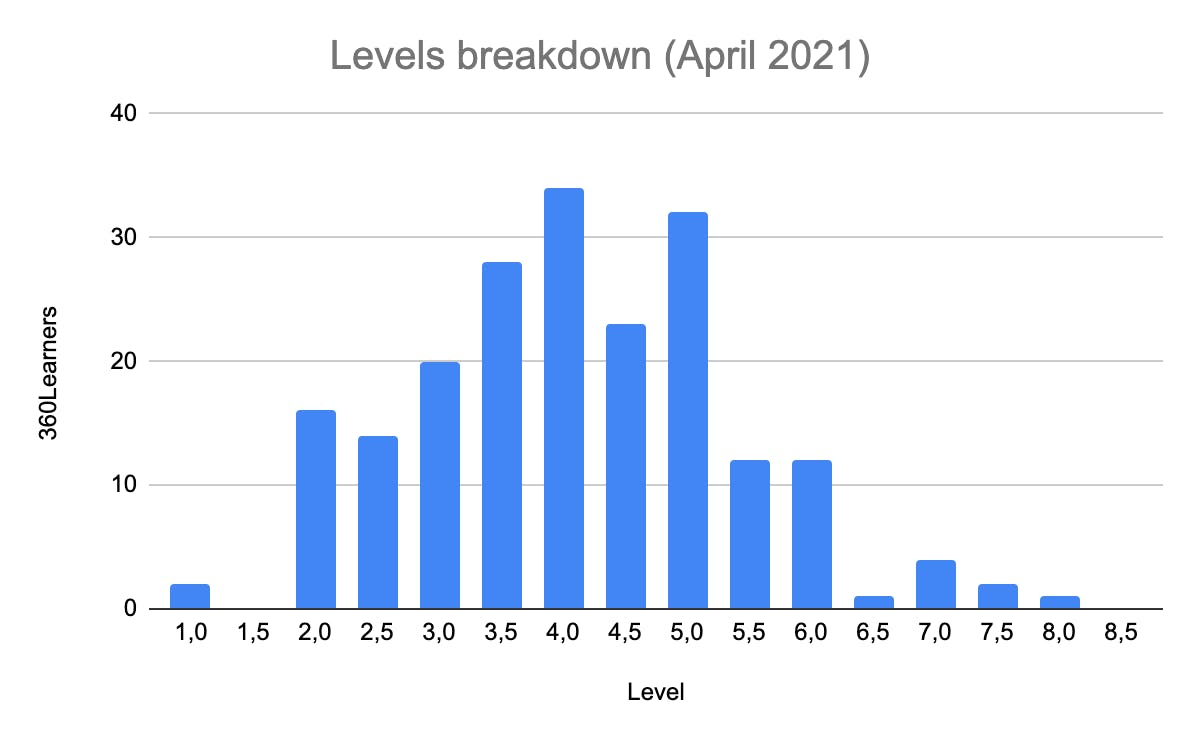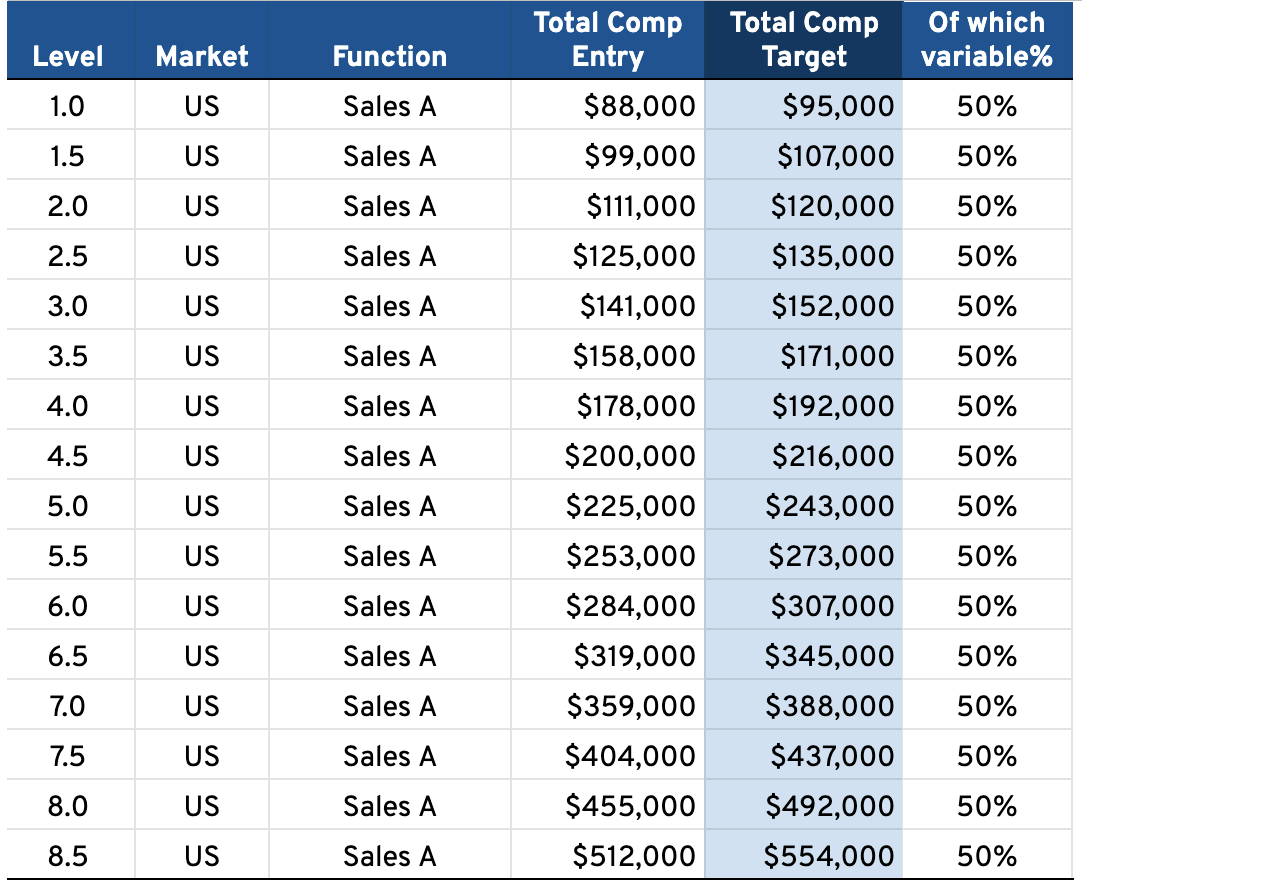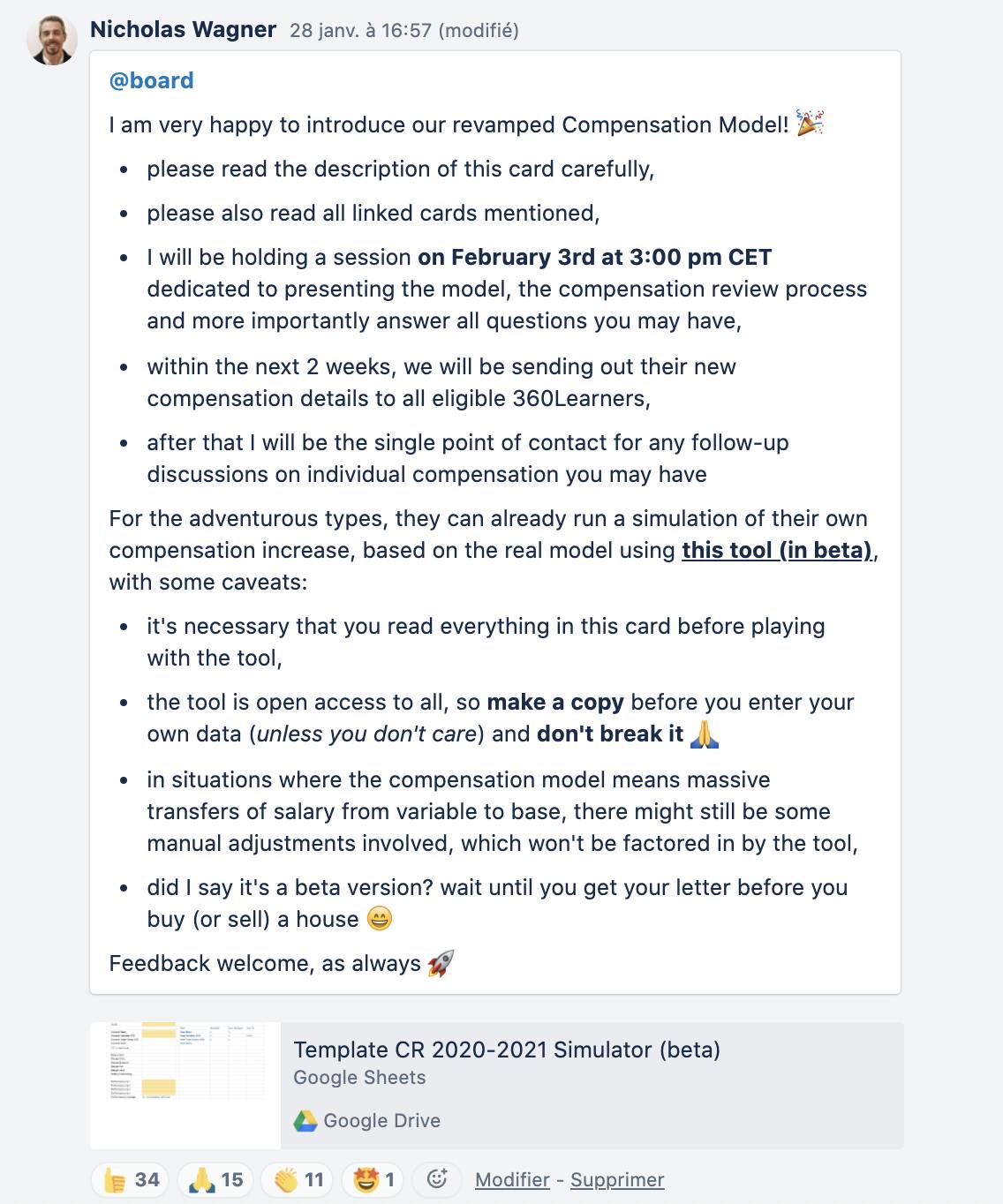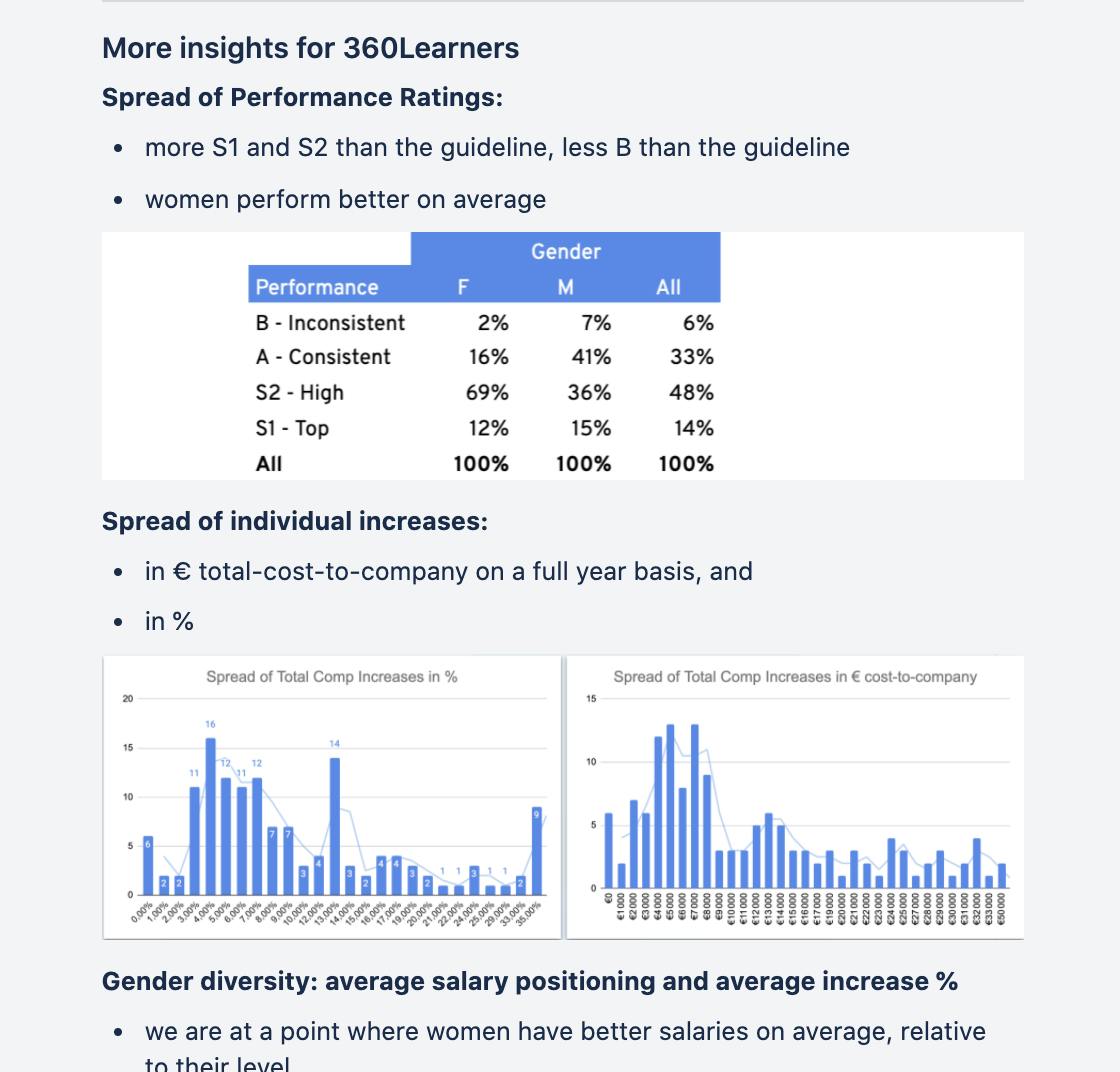Like all mature organizations, we use salary ranges to structure our compensation policy at 360Learning. Unlike what happens in many organizations, our salary ranges aren’t just a soft guideline that falls apart whenever reality comes knocking on the door: they are law.
When the yearly Compensation Reviews come up, our salaries are calculated, not negotiated. And our laws are entirely transparent, as all laws ought to be. This is our way to stay accountable, operate with low authority, and eliminate bias.
In this post, we’ll continue our 360Learner journey series with a deep-dive into our compensation policy. We’ll explain why our policy of transparency is so important to us, and how not negotiating salaries contributes to our environment of trust and accountability.
L&D leaders: Are you getting paid what you really deserve? Check out our Salary Negotiation Cheat Sheet.

Are you being paid what you're worth?
By providing your contact info, you agree to receive communications from 360Learning. You can opt-out at any time. For details, refer to our Privacy Policy.
We don’t negotiate salaries–here’s why
So, why don’t we negotiate salaries? It all comes down to four key compensation values: high accountability, low authority, simplicity, and zero bias.
1. High accountability
We trust 360Learners–and aspiring 360Learners–to be capable of handling important information like salary bands. That’s why we practice transparency around compensation management, and keep each other honest by not hiding anything.
2. Low authority
We use the OKR system to drive performance, and we don’t want our coaches to lead with the paycheck. That’s why coaches aren’t in charge of compensation decisions at 360Learning. This helps us live our commitment to low authority.
3. Simplicity
For a lot of organizations, compensation questions take up way too much time. In contrast, our Compensation Review this year was just one all-hands meeting during which we shared the model, as opposed to the typical dozens of alignment meetings and one-on-one discussions.
4. Zero bias
We have a model that’s mathematical, and we don’t authorize ourselves to deviate from that. This means our salary levels aren’t affected by personality biases or social inequities, such as the fact that 60% of women say they never negotiate their salaries.
The upshot? Receiving an offer from 360Learning will be the last time you have to negotiate your salary. Even then, you might feel like we’re not giving you a lot of wiggle room…because we aren’t.
So, how do we manage career progressions? It’s all about calculating the right level.
Receiving an offer from 360Learning will be the last time you have to negotiate your salary.
What we do instead: use Levels to manage career progression
Internally, we use a factor-based method to compute Levels and manage career progression for every 360Learner. We do the same with candidates, based on how we assess them against the requirements of each role, and using our current teams as comparators. As you interview with us, the interviewing team assigns you with a Level, which then comes into focus as you progress through the stages of the hiring process.
That’s right: the Level is about the candidate, not just the job. We will accept that a more or less experienced candidate will take a role if we feel they will have a matching impact and bring something major to the team. That’s why we don’t start by defining a fixed Level for a role.
When we make you an offer, we tell you what your default Level is. This Level is not negotiable–we know better than that–and is visible to all other 360Learners when you join. In return, you’ll see the Level of all 360Learners. In our experience, this transparency is the best way to calibrate ourselves as a collective, make the best decisions, and keep everyone honest.
We use 8 Levels with intermediate steps (so the total is really 16), and we use the same scale for coaches and non-coaches alike. You can expect to grow to the higher Levels without having to become a coach, provided you demonstrate strong impact. This is particularly important to make sure only those who want to coach become coaches. We may come back to this blog with full details on the Level grid at a later stage, so stay tuned.
At the time of writing this article, I’m also inserting the high-level scale with title equivalencies plus the current breakdown in Levels at 360Learning. In general, titles don’t mean much to us: if you get the Level you can use the title, but sometimes you can still use a higher Level title–or you can choose not to use the title at all.


Now, let’s get into the real details: our salary ranges.
We pay well above the market average
Okay, so you have your Level, now what? We go to our salary ranges. These ranges are designed to target the 70th percentile of the tech market, meaning we want to be within the top 30% when it comes to cash compensation. We build our ranges based on market data purchased from specialized vendors. Our salary ranges are reviewed each year so as to fully capture the market movements and our company’s hypergrowth.
We have one set of salary ranges for each job market we operate in (as of writing this, France, the United States, the United Kingdom, and Germany), and one salary range for each distinctive group of functions (we have eight ranges at the moment: Sales, Business Development, Sales Engineering, Client Success, AI/Machine Learning, General Tech, Support/Admin, and Default).
Each salary range determines how much we offer. For example, if you apply for an Account Executive role in the United States and we assess you as a Senior Manager 4.5, you’ll be matched against the US - Sales - 4.5 range.
Here’s what our US Sales salary range looks like in practice:

In our US-based Account Executive example (an individual contributor, not a coach), if we assess you as 4.5, our offer will never be lower than $200,000 (consisting of 50% base and 50% variable), and could go as high as $216,000. We’ll offer what we need to within the range of $200,000 and $216,000.
You can think of this $16,000 or so as your “negotiation margin”. If you expect more, we’ll pass. If you expect a lot less we’ll still make you an offer at the entry level. Given what we all expect from each other, we have no intention of being cheap on our future teammates. In some cases, that means raises of 25% or more.
The same thing goes internally. When we reviewed our ranges earlier this year, we found we had a few people below the range. We adjusted our salaries as a result, and this translated into a lot of two-digit % increases.
So, what about our equity grants? Well, they function exactly the same–except for the negotiation margin which is a strict zero. But that’s a complicated discussion, and something we can come back to in a later post.
Enter the Matrix: how we handle Compensation Reviews
You made it! You’re now a 360Learner, curious as to how we’ll handle your compensation going forward.
The salaries for every 360Learner are reviewed every year effective January 1st, in a process called the Compensation Review. Provided you have 3 months tenure as of January 1st you’ll be included in the Review. But if you have less than 12 months tenure as of January 1st, you’ll receive a simple prorated increase %.
Just like salary ranges, Compensation Reviews are an automated process, not a negotiated one. Compensation Reviews leverage dedicated tools and data gathered throughout the year–and they have nothing to do with your salary negotiation skill.
Instead, we base these Compensation Reviews on the following three factors:
1. Your Level:
- We use your Level to determine the applicable salary range so that we remain competitive and fair, ensuring a smooth and structured compensation growth.
- Twice a year in June and December, 360Learners who feel they have increased their impact can raise their hand to be re-assessed and “Level-up”.
2. Your performance
- We use this to pay for performance. Everything else being equal, people who perform better get higher raises.
- We hold quarterly performance reviews to finalize a performance rating. Then, we average out the last four quarters as input for the Compensation Review.
3. Your salary positioning
- The higher your positioning is, the lower the raise. Everything else being equal, people who are paid less get higher raises than people who are paid more.
- This positioning is equal to the current total compensation of the 360Learner divided by the target total compensation of the applicable salary range.
Then, we bring all of these factors together in the Merit Increase Recommendation Matrix. This is the tool we use to optimize our budget use at scale. Here’s what it looks like:

We rework our Merit Increase Matrix each year based on the company-wide budget for compensation increases–because we don’t like spending money we don’t have 😀. In the above example, we are envisioning a 5% budget for compensation increases.
We also rework the Merit Increase Matrix based on the actual spread of performance ratings in the company, because we won’t differentiate based on how different 360Learning teams assign performance ratings.
What does that mean in practice? Since we don’t do forced rankings, our distribution of performance ratings is flexible, and depends on what is actually achieved. And yet, we can’t afford to give all top performers 3x the budget if there are 50% of them at the end of the year, so we do need to adjust the Merit Increase Matrix to some extent.
As a 360Learner, you can compute your own raise!
By the time December rolls around, every 360Learner knows their Level and their performance ratings, and they have access to the salary ranges and the Merit Increase Matrix. Now, they can calculate their own raise–but we’re making it even easier by providing them with a simulator!

We also send each 360Learner a letter to formalize the outcome of Compensation Reviews and avoid misunderstandings or miscalculations. The People and Culture team is here to resolve any issues, but out of the 150 people in scope of the review this year, fewer than 10 came back with questions–and no exception to the model was implemented. That’s fairness in practice!
We also make sure to provide insights into the process and share these with everyone to provide perspective on the exercise.


Why ‘computing, not negotiating’ suits us better
So, that’s it. That’s how we manage compensation at 360Learning. As far as process goes, we believe our approach to ‘compute, not negotiate’ is the best for us, because:
- Our transparent model makes salaries highly predictable for 360Learners.
- We avoid frustrating discussions.
- Coaches are relieved of compensation discussions–and they can’t use them to directly incentivize performance.
- Compensation is not correlated to a 360Learner’s skill as a salary negotiator. Our model will either be used for everyone or changed for everyone–but never changed for just one person only.
While we know some people are better incentivized by the vague promise of a potential raise in the future and might be turned off by a transparent system that says exactly what it will do and sticks to it, we feel the 360Learning crowd expects to be given the full picture.
So, what about you? How does your company handle compensation?
If this article has left you thinking about a career with us, then check out our list of current opportunities–we’d love to hear from you!


